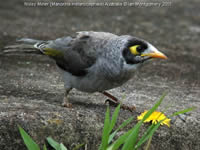 NOISY MINOR NOISY MINOR
Description:
The Noisy Miner is a bold and curious bird. It is identified by its mostly grey body and black crown and cheeks. The bill is yellow, as are the legs and the naked skin behind the eye. The name is well suited as the common calls – loud ‘pwee pwee pwee’ and a piping ‘pee pee pee’ when alarmed – are uttered repeatedly by the members of the colony.
Despite their moderate size (28 cm), Noisy Miners aggressively attack larger birds such as hawks and kookaburras. These attacks may be so vigorous that most other birds are excluded from an area occupied by Noisy Miners.
The similar Yellow-throated Miner, M. flavigula , has a grey crown, white rump, and a line of bare yellow skin on the sides of the throat.
People often confuse miners with the introduced Common Myna, Acridotheres tristis . The Common Myna is quite different in plumage (mostly dark brown) and, although it has similar facial markings, belongs to the starling family, while the miners are honeyeaters.
Distribution and Habitat:
Noisy Miners range from northern Queensland along the eastern coast to South Australia and Tasmania. They are found in woodlands and open forests. They have also become well adapted to suburban situations and are a common sight in parks and gardens.
Food and feeding:
The Noisy Miner feeds on nectar, fruits and insects. Very occasionally they will eat small reptiles and amphibians. Food is either taken from trees or on the ground. In keeping with its highly social nature, the Noisy Miner usually feeds in large groups.
Breeding: Noisy Miners breed in small to large colonies. The season extends from July to December and several broods may be reared in this time. The female constructs the nest and incubates the eggs alone, but both sexes will care for and feed the young birds. Additional ‘helpers’ usually also feed the young. Interestingly, these helpers are almost always male birds.
Back to top
|

